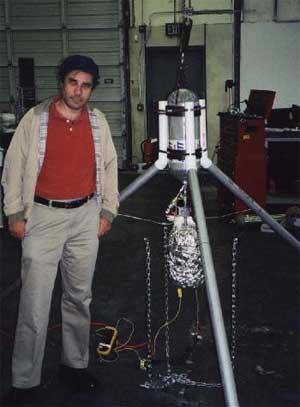The drone will receive its electrical energy from a large array of solar collectors that will be built on its wings. So, the jet will use this energy to filter the carbon dioxide from the vaporizing atmosphere, and store it as a liquid in the fuselage

The drone will receive its electrical energy from a large array of solar collectors that will be built on its wings. So, the jet will use this energy to filter the carbon dioxide from the vaporizing atmosphere, and store it as a liquid in the fuselage. When enough gas is stored to fly, the CO2 will be heated. Once heated, the gas will act as a thruster, helping the rocket to lift off vertically from the Martian surface. Once the cricket is in the air, it will be able to emit more gas from its rear propeller, and will use its large wings for lift and maneuvering. When ready to land, the cricket will slow down and touch the ground softly in a vertical landing.
The idea of the cricket is the brainchild of Robert Zubrin, author of the book "The Case for Mars", president of the Mars Society, and president of Pioneer Astronautics. Hatzergez is one of 219 research projects selected by NASA for the Small Business Research and Development Award.
Zubrin sees the rocket not only as a technology for Mars research, but also as a basis with which NASA will be able to deal with future engineering problems, robotic and human. "Assuming that we want to perform a simple return mission, we want to know how to build a propeller that will be sufficient for the return journey," explains Zubrin, "and the rocket will allow us to test many takeoffs and landings while avoiding danger, in any terrain."
"The firecracker will use the carbon dioxide as fuel, thus not polluting the soil with hydrocarbons," Zubrin continues. This is important, because a NASA spacecraft using hydrocarbons as fuel could contaminate its landing site with chemicals that could interfere with the search for life on Mars. "As soon as the cricket starts moving, it will find an area of primeval and pristine water to explore."

The simplest model of the drone will be extremely light - weighing about 50 kg, compared to the weight of the robotic vehicles currently on Mars - 185 kg each. We'll increase the weight a bit, and the spacecraft will be able to carry a number of "Mini-Rovers" [Mini-Rovers], equivalent to the tiny Soujourner that was part of the Pathfinder mission. These small robots will be able to be sent to the places with the most interesting characteristics, which will be determined by the aerial scans of the drone.
Another advantage of the cricket is its complete disregard for terrain conditions. When NASA selected the landing sites for its previous Mars robots, relatively flat sites were chosen in selected areas so that the robots could travel at useful speed. The cricket can land on the edge of an abyss, explore the area, jump to the bottom and come back up. This would give scientists an unprecedented range of flexibility in testing for water or life on Mars.
But, as in everything, there is a trap here too. The rocket requires a lot of electricity to compress and heat the carbon dioxide, and it will take more than a month to charge its solar cells before the entire takeoff.
In order to generate more electricity, NASA will consider using a Radioisotope Thermal Generator, similar to those carried on Cassini, Viking, or the Mars Science Laboratory that will be launched in 2009. With a more powerful electrical system, the rover would be able to take off once every few days, eventually roaming the entire planet Mars.
Zubrin's company, Pioneer Astronautics, has already done a lot of testing and significant research around the idea, and developed a ballistic prototype for the rocket for NASA's Jet Propulsion Laboratory in 2000. The engine worked well in the lab, and they were able to get the vehicle (weighing 50 kg) to fly. By operating a remote control, and under submersible gravity conditions (with the help of a helium balloon).
Instead of sitting and resting in one place, or crawling slowly across the surface of Mars, future robots exploring Mars may raise a chicken. Well…. Jump, anyway.
For information on the Universe Today website
The Israeli Astronomical Society
